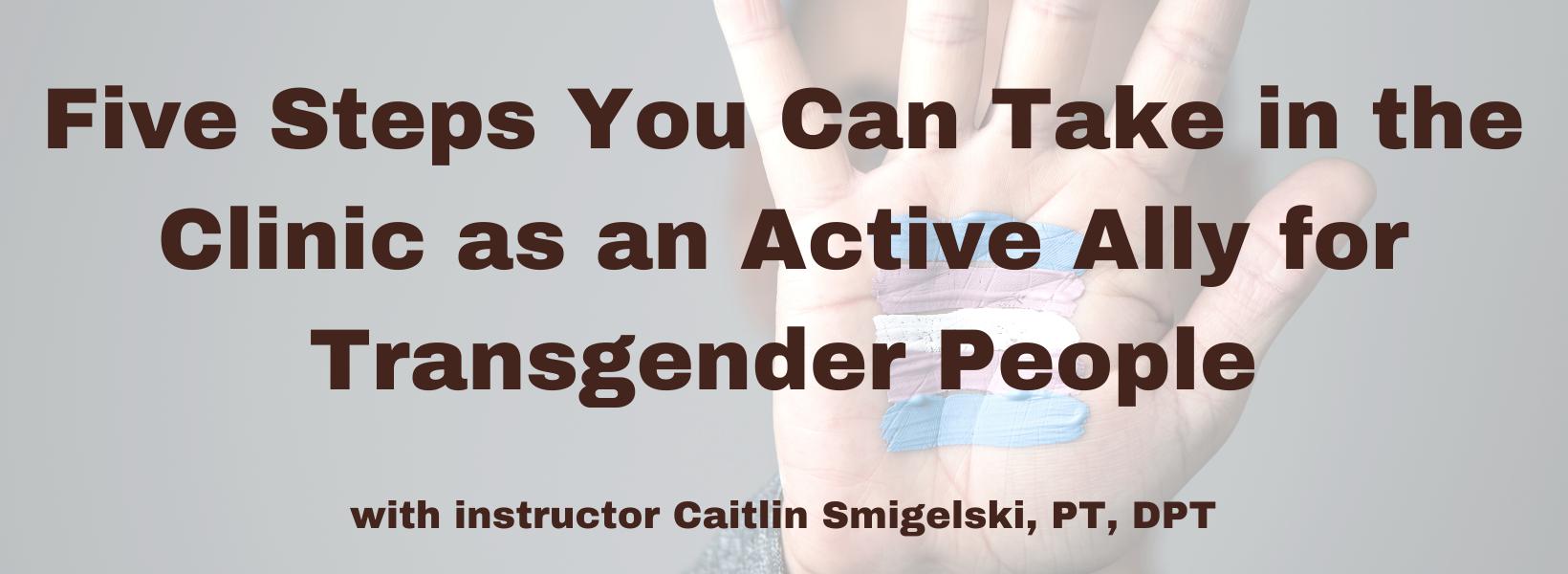Five Steps You Can Take in the Clinic as an Active Ally for Transgender People

Caitlin Smigelski, PT, DPT is a pelvic floor physical therapist in Portland, OR. She focuses in the treatment of bowel and bladder dysfunction and complex pelvic pain and specializes in transgender health and the treatment of patients who are pregnant or postpartum. Caitlin values active treatment approaches and teaching individuals ways to manage and improve their symptoms. She is active with the Academy of Pelvic Health Physical Therapy and serves on the CAPP-OB committee and is also a member of the World Professional Association for Transgender Health (WPATH). Caitlin and Sandi Gallagher traveled to Argentina to present at the 2018 WPATH Symposium on Physical Therapy in People Undergoing Vaginoplasty.
As Pride Month comes to an end, it’s important to reflect on how healthcare providers can promote a safe and inclusive environment for all patients. Members of the transgender community face discrimination and increased barriers to accessing healthcare. According to a 2022 survey by the Kaiser Family Foundation of transgender adults
- ● 38% report it is somewhat or very difficult to find a healthcare provider who treats them with dignity and respect.
- ● 47% report healthcare providers know “not too much” or “nothing at all” about providing care to trans people
- ● 31% report having to teach a provider
- ● 29% have been asked unnecessary or invasive questions by a healthcare provider
Healthcare providers need to improve the care it provides the transgender community. By being an active ally in your clinic, you can facilitate positive change. Active allyship is when a person with privilege and power supports people who are marginalized. It requires more than just solidarity, but taking action. Below are just a few steps you can take to improve the experience of a transgender person in your clinic.
- Pronouns:
○ Share your pronouns verbally, on your ID badge, bio, business card etc. This normalizes the act of sharing one’s pronouns and creates a safer space for all.
○ Ask all of your patients for their pronouns via an intake form or during the interview.
○ Never assume someone's gender identity based on their appearance, and don't hesitate to ask individuals for their pronouns.
○ Correct coworkers if they misgender a patient, even when the patient is not present.
- Gender-neutral language:
○ Edit intake forms for inclusivity. Ask about sex assigned at birth, gender identity and pronouns followed by a blank space for the patient to fill in.
○ Avoid gendered language in the clinic such as guys and ladies and gentlemen. Instead use terms like folks, y’all, people, everyone etc.
○ Only use gendered terms like Sir, Ma’am, Mr. and Ms. once someone has shared their gender and pronouns.
○ Don’t assume the relationship or gender of a person who comes with your patient to an appointment
- Bathrooms:
○ If your facility has single stall bathrooms, make them gender-neutral.
○ If a single-user restroom is not an option, post signs and have a written policy that supports people to use the bathroom that matches their gender identity.
- Policies and Statements
○ Use your voice to advocate for inclusive policies within your healthcare institution. Encourage the adoption of policies that protect transgender patients from discrimination, such as:
■ the availability of gender-neutral bathrooms
■ gender-affirming documentation processes
■ non-discriminations policies inclusive to transgender individuals
■ publishing statements supporting health care for transgender people and youth
■ staff trainings
○ Encourage your professional organization to publish a statement in support of transgender healthcare. Many professional organizations have already issued statements, including the AMA, AAP, ACOG, ANA, ACNM, and WHO.
○ Learn about laws and policies affecting transgender people where you live. When discriminatory and harmful laws are present, call or email your representative or sign a petition to support positive change.
- Educate yourself and your coworkers
○ A key step towards becoming an active ally is to educate yourself about transgender identities, experiences, and healthcare needs. Understanding the unique challenges faced by transgender individuals will enable you to provide compassionate and informed support.
○ Read books, articles, and research papers written by transgender authors or experts in the field.
○ Take a course specific to rehabilitation. Herman and Wallace offers two remote courses: Transgender Patients: Pelvic Health and Orthopedic Considerations (17 contact hours) and Inclusive Care for Gender and Sexual Minorities (15.5 contact hours)
○ Learn from online resources. A few examples include the National LGBTQIA+ Health Education Center through the Fenway Institute, the World Professional Association for Transgender Health, the University of California San Francisco Gender Affirming Health Program, and the National Center for Transgender Equality
○ Share key information with all clinic staff including those in non-clinical roles
By cultivating a welcoming and inclusive environment, advocating for policy changes, and seeking new learning opportunities, you can make a significant difference in the lives of transgender people by helping to create a healthcare system that is truly inclusive and affirming for all.
Transgender Patients: Pelvic Health and Orthopedic Considerations

Price: $500.00 Experience Level: Beginner Contact Hours: 17 hours
Course Dates: August 19
Description: This course is appropriate for any physical rehabilitation professional, regardless of their specialty area, who has an interest in better serving people who are gender diverse. There is specific content aimed at teaching pelvic health therapists how to expand their skills for working with people of all gender identities. There will be particular education regarding gender-affirming genital surgeries as well as a discussion of other gender-affirming surgeries and medical interventions that people transitioning might choose.
Often times therapists think of genital surgeries and sexual function when contemplating work with transgender people. Therapists have far more to offer transgender patients. For providing optimal care, knowledge of the intricacies of gender transition is essential. We provide that overview in this course. Topics covered include:
- Societal influence on gender transition including interactions with healthcare providers
- Recognizing the difference between sex, sexuality, and gender
- Understand the complexities of the legal system for the person transitioning gender
- Tips and tools for a trauma-informed intake and examination
- Health effects of hormones for gender transition as related to differential diagnosis in rehabilitation
- Supporting healing after gender-affirming surgery
- Operative procedures for face and chest
- Operative procedures for masculinizing and feminizing genital surgery
- Pre-operative evaluation, treatment, and education issues
- Post-operative evaluation, treatment, education and follow-up for genital surgeries
- Outcome measures with rehab focus for people undergoing gender-affirming surgeries
- Fertility and pregnancy in gender-diverse people.
By accepting you will be accessing a service provided by a third-party external to https://www.hermanwallace.com/




































